Is Marriage Really on Its Way Out?
Not long ago I was presenting some of my research at a national summit for relationship educators. This incredible and dedicated group included those who work with and support marriages every day in cities around the country. They are doing amazing and often challenging work. And yet I sensed an undercurrent of discouragement about the state of marriage today – an undercurrent I hear from both leaders and average men and women in churches, on airplanes, and in official focus groups.
As most of you know, I have spent a lot of time debunking some of the most damaging, hope-sucking myths about the divorce rate (no, the overall divorce rate is not 50%, and no, the rate of divorce is not the same in the church, and so on). You can see The Good News About Marriageor search my recent articles on that topic, so I won’t revisit it here.
Instead, I want to investigate a completely different theme that I hear when people sound discouraged about marriage: the decline in rates of marriage and the rise in cohabitation.
Now those concerns overall are real; the data shows both trends are going the wrong direction. And given the crucial power of marriage for human flourishing, I think anything that hurts marriage is something to take seriously and address as robustly as possible.
But I also think our perspective is a bit skewed.
For a moment, think about the demographic of couples 25-34 years old who are living together. If I were to ask you to guess, what percentage do you think are cohabiting rather than married?
Take a moment to consider that question, and then read on for several truths that put the “state of marriage” problem in perspective.
Truth #1: The magnitude of cohabitation rather than marriage isn’t what we think it is.
When I ask people what percentage of 25- to 34-year-old, living-together couples are unmarried, most guess in the 50-75% range. In other words, we think most young couples who live together are shacking up rather than making a marriage commitment.
The actual ratio is 26%. A full 74% of those who live together at that age are married. Puts a different spin on things, doesn’t it?
(See more of this data from a National Center for Family & Marriage Research analysis.)
Truth #2: The negative-seeming trends aren’t all for negative reasons!
If you read the news, you will see all sorts of speculative (and depressing) reasons for why marriage rates have reduced. As a 2021 article in The Hill put it, those reasons include “declining religious adherence to marriage, public disenchantment with marriage, and more recently, unstable jobs and strained finances…”
And yes, again, I’m not saying that those things aren’t real. They are.
But let’s zoom out and look at the bigger picture. According to the Census Bureau, the marriage rate declined almost 9% from 2011 to 2021. Yes, that is a lot in a short time. But during that same period, the divorce rate declined by 29%! Yes, you read that right!
One reason that might help explain both trends may simply be that more people are waiting longer to get married, with the average age of marriage rising to age 30 for men and 28 for women. Here’s how that might work for each:
The divorce rate. People who get married older find that their relative maturity is protective. In a landmark 2011 analysis, Harvard-trained economist and researcher Dana Rotz quantified that fully 60% of the decline in the divorce rate since 1980 was due to the simple, protective factor of people getting married at older ages. She hasn’t updated that analysis recently, but it seems likely that this factor continues to matter.
The marriage rate. I haven’t seen an analysis on this, so this is speculative. But from what I can tell, some of this is probably pure math. The marriage rate is the number of marriages per 1,000 women each year. So doing a very simplistic analysis, think of the universe of people in the prime ages of 25-31, and pretend that they are “not available for marriage” until they hit the average age of marriage (I told you this was simplistic). As the age of marriage has risen, the population of those ages 25-31 who are “not yet available” has grown relative to that group as a whole, and those who are “available to be married” has shrunk. So there is simply a smaller universe of people in that group who are already at the average marriage age and thus available to tie the knot than there were ten years ago. Obviously, this math is ridiculously simple and will not be a real accounting for the decline in the marriage rate, but the concept is likely to be a meaningful part of it.
Truth #3: There still are powerful incentives today to get married.
People will usually act in their own self-interest. And ironically, for an institution that is based on prioritizing the other person, it is simply in most people’s self-interest to get married once they find that right partner! Pretty much every analysis that has ever been done has found that marriage, overall, promotes human thriving; married people have better health, are less likely to be depressed, and much more likely to be happy. Married people are more likely to be better off financially, live longer, and simply enjoy their relationship more.
So if you have any group of relatively rational non-married couples who are looking at real humans who are married versus those who are not married, most of those relatively rational people will conclude that this marriage gig is not such a bad idea.
Unfortunately, there are still far too many groups (such as those who are less-educated, or certain ethnic minorities) who view a lifelong, happy marriage as unattainable and thus hold themselves back from that all-important commitment. And because those issues are real, it is up to all of us to continue to push back against the discouraging “marriage is doomed” narrative when there are indeed real and encouraging truths about marriage that, in most cases, is such a key part of helping people thrive.
If you are interested in having Shaunti bring research-based strategies, practical wisdom and biblical principles to your next event, please contact Nicole Owens at [email protected].
Transform Your Relationships with Kindness! Join the 30-Day Kindness Challenge and Embrace the Power of Positivity. Watch as Kindness Strengthens Your Connections and Creates Lasting Bonds.
Please note: This post may contain affiliate links. As an Amazon Associate we earn a small amount from qualifying purchases through these affiliate links. This doesn’t cost you anything, and helps us continue bringing you great content!







